HISTORY OF RUSSIAN SUKHOI
FIGHTER AIRCRAFT - Page 1
Sukhoi Employs Over 29,000 Workers
Russia presently has two major aircraft production corporations, both building a most impressive array of military jet fighters. SUKHOI and MIKOYAN (MIG) through the years have continued to improve the performance of their fighters, resulting in some exceptional performing aircraft. In doing research on the Sukhoi I noticed the remarkable resemblance of various models of the two corporations. Sukhoi has produced recent aircraft which are almost identical to the Mig-25 "Foxbat," Mig-29 "Fulcrum," Mig-31 "Foxhound," Mig -33 "Fulcrum-Plus," and Mig-35D Fulcrum F. It seems obvious that both companies are closely designed to work together to produce the most acceptable aircraft. This is only a personal observation with no actual facts. Sukhoi with over 29,000 workers is certainly a sizeable corporation which has produced many superior fighters. Their fighters are capable of exceptional speed, maneuverability, have excellent electronics and can carry a full range of missiles.
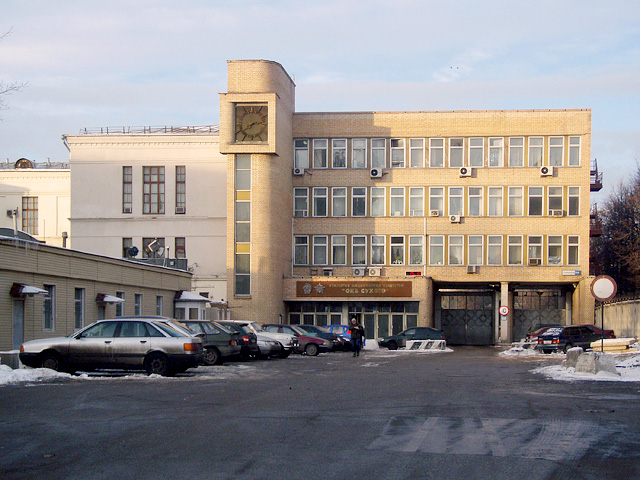
SUKHOI DESIGN BUREAU
Sukhoi is headquarted in Moscow. The Russian government merged Sukhoi with Mikoyan, Ilyushin, Irkut, Tupolev, and Yakovlev as a new company named United Aircraft Building Corporation. Specifically, Mikoyan and Sukhoi were placed within the same operating unit. Currently Sukhoi's Su-24, Su-25, Su-27, Su-30, Su-34, and Su-33 are in service with the Russian Air Force and Navy. A total of over 2000 Sukhoi aircraft were supplied to foreign countries on export contracts. Sukhoi is probably the leading manufacturer of aerobatic aircraft. Russia launched on Sept. 26, 2007, its first modern commercial regional airliner, the Superjet, built by Sukhoi. Sukhoi is also working on what is to be Russias fifth-generation stealth fighter, the Sukhoi PAK FA. First flight took place Jan 2010. The company has also produced a fighter with forward swept wings which I believe will eventually be replaced with conventional wings.
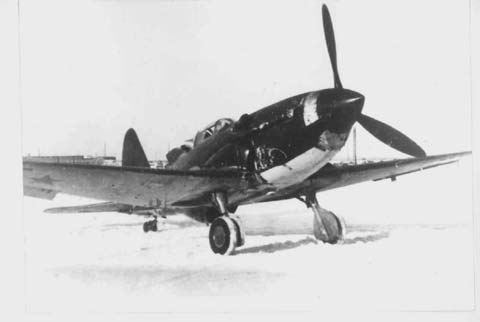
SUKHOI SU-1/ SU-3
The Sukoi SU-1, was a high altitude fighter aircraft built at the beginning of WWII. The Su-3 was an improved version of the SU-1. The key feature of this aircraft was a pair of turbochargers driven by exhaust gasses from the Klimov V-12 engine. It reached a speed of 400 mph at 32,810 feet. The turbochargers were unreliable and the advanced SU-1 was designated the SU-3 with a revised wing. The project was abandoned and the SU-3 never flew.

SUKHOI SU-2
The SUKHOI SU-2 was the first aircraft actually designed by Pavel Sukhoi. Reportedly used as a light bomber in WWII. Over 800 were built. It carried a pilot and a gunner. The landing gear and tailwheel were retractable. A modified version was named the SU-4, however it was obsolete and underarmed at the start of the war. Speed of the SU-4 was reported at 300 mph at altitude. Ceiling was 27,560 ft. Armament was six 7.62mm machine guns, plus 880 pounds of bombs and up to 10 rockets.
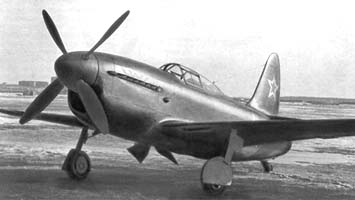
SUKHOI SU-5
The Sukoi SU-5 was a Soviet mixed- power (propeller and motorjet) prototype fighter built near the end of the war. Russia did not have a turbojet engine, so their efforts were directed toward- mixed power using a small rocket or jet engine for bursts of speed, allowing the SU-5 to reach 493 mph at 14,270 feet. Due to many engine failure problems this project was also cancelled.

SUKHOI SU-6
The Sukhoi SU-6 was developed as an armored attack aircraft, however it was dependent on the availability of the M-71 engine. The SU-6 with the M-71 was faster than enemy fighters. Modifications again became a problem, such as converting the aircraft to a two seater. The project encountered more problems when the AM-42 engine was used to replace the M-71. The M-71 was much faster than the AM-42, however due to the M-71 being completely unavailable, production was begun on a limited basis with the AM-42.
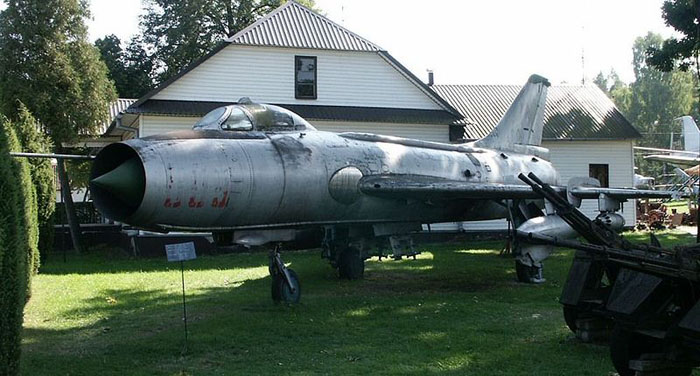
SUKHOI-7 BKL
The Sukoi-7, NATO name FITTER-A, was a turbojet powered fighter bomber,
produced in an effort to copy the American F-86. The first prototype,
the S-1, flew on 7 Sept. 1955. Fitted with an afterburning version of
the AL-7 engine, after eleven flights the prototype set a Soviet speed
record of 1350mph. The second prototype, the S-2, was complicated by
the once again unreliable engine, and crashed killing its pilot. The aircraft
entered service as the SU-7 BKL in 1957 but saw only limited use. After
many structural refinements for high speed, low altitude operations, its
name was changed to the SU-7. The SU-7 had many variants which were mostly
exported. A total of 1847 SU-7s and its variants were built, with 691
exported. Successful take offs and landings were a problem, with the SU-7
finally using JATO rockets. Final speed of this much modified aircraft
was reported at 1335 mph at high altitude, and an impressive ceiling of
57,740 feet. Armament consisted of two 30mm cannon, and a large selection
of bombs and rockets, including a 5 KT nuclear bomb.
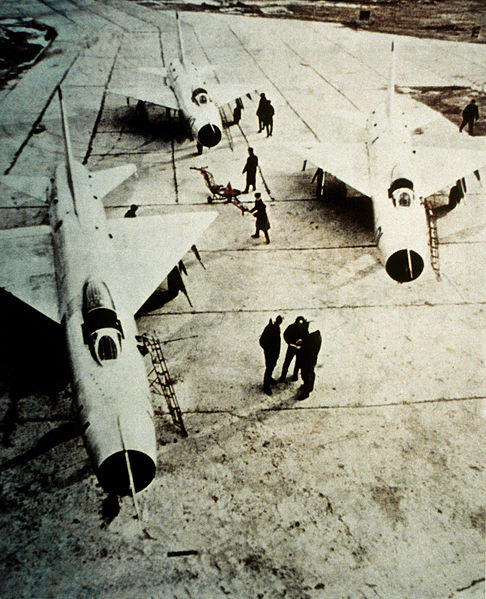
SUKHOI SU-9
The Sukhoi SU-9, NATO name FISHPOT, was a single engine, all weather, missile armed interceptor aircraft developed by the Soviet Union. The design was dubbed FITTER-B. Total production was over 1100 aircraft. Some of the SU-9s were upgraded to the SU-11 FISHPOT-C form. The SU-9 was finally replaced by the upgraded SU-11, and the far superior SU-15 FLAGON. It was reported a SU-9 was near the Francis Gary Powers U-2 over Soviet territory on 1 May 1960. The SU-9 was unarmed and directed to ram the U-2. The first attempt missed due to speed difference. A lack of fuel put an end to the ramming attempt. Maximum speed was reported at 1325 mph at high altitude. The ceiling was 55,000. In a further attempt to salvage the work already spent on the project, another prototype was developed, the SU-13. Speed was not sufficient and the entire project was abandoned.

SUKHOI SU-9 SAMOLYET K
The Sukhoi SU-9 Samolyet K was an early jet fighter built shortly after the war. It was the basis for the SU-11 Samolyet LK and the SU-13 Samolyet TK. The plane was hampered by the stigma associated with the almost identical resemblance to the German ME-262. Although having advanced features such as an ejection seat, JATO rockets, and brake parachutes it was abandoned in favor of the more advanced SU-11 LK. It was further modified by installing more powerful turbojets. Engines again made the aircraft unreliable and the project was abandoned.
SUKHOI SU-11
The Sukhoi SU-11 was developed from the SU-9, the FISHPOT interceptor.
The SU-9 was developed in parallel with the SU-7 swept wing fighter bomber.
The delta wing SU-11 was fitted with a more powerful turbojet giving it
more afterburner thrust for improved climb rate and high altitude performance.
Armament consisted of radar homing and infrared guided missiles. About
108 were produced. Top speed was listed as 1194 mph at 36,000 ft. It was
produced from 1962 - 1965.

SUKHOI SU-15
The SU-15 FLAGON was a twin engine interceptor that replaced the SU-11. After the poor showing of the SU-9 and SU-11 Sukhoi quickly began the development of a heavily revised and more capable aircraft. The initial SU-15 was the NATO FLAGON -A. Take off and landing was a seemingly endless problem for Sukhoi so major wing modifications were made. The SU-15T also proved troublesome so production was ceased after only 10 aircraft had been built. Other modifications and a new name designation ended with the final SU-15Ums produced in 1979. More modifications were proposed but were rejected in favor of developing the MIG-23 interceptor. Armament was four missiles and four cannon. 1290 SU-15s were built. They were scrapped in favor of the SU-27 FLANKER and the MIG-31 FOXHOUND.

SUKHOI SU-17/20/22
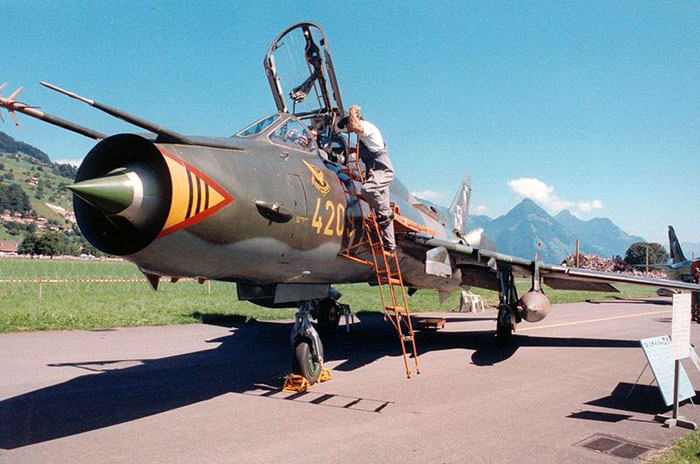
SUKHOI SU-22